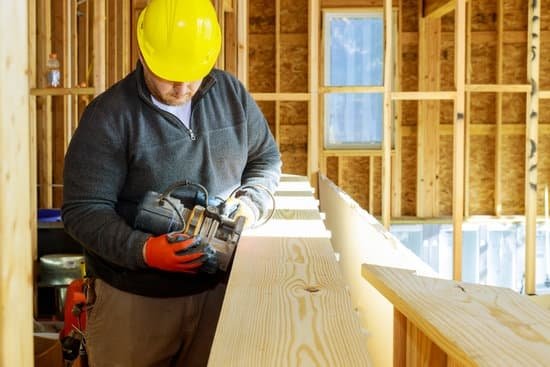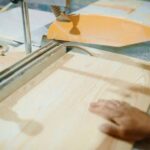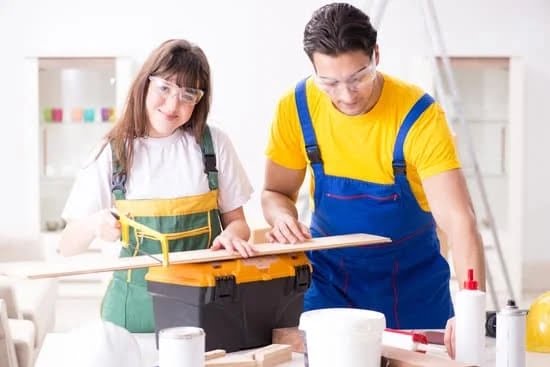Introduction
Corner joints woodworking is a type of joinery (joining two pieces of wood together) that involves joining two pieces of wood at an external angle. Corner joints are used to create quickly and easily a strong structural support, while also adding an aesthetic value to the project. This type of joinery can be used in many types of projects from furniture construction to bookcases, frames, and cabinets.
When working with corner joints for woodworking there are many different ways to go about it, depending on the specific project. The most common way is using rabbeted corners or using components such as corner or junction blocks; these look similar to miter cuts but are much more secure and provide a cleaner, smoother look when completed. Other options for corner joint include angled butt joints which involve cutting both pieces of wood at 90-degree angles and then having them share equal widths at the joint, grooved miters which require sawing out small grooves along the edge of each piece, and lap joinery which has two pieces overlapping each other at right angles.
Elements like dowels, biscuits and screws can be employed when making corner joint connections to make sure they stay in place while being worked on. Strong adhesives are also very important in order create a complete hold so when sanding or painting later there won’t be any gaps between two jointed parts. Finishing touches may involve burnishing the edges with fine grit sandpaper if necessary so there’s no need for worry about warping panels or leaving bumps on them either.
Description of Different Corner Joint Designs
Corner joints are one of the most common woodworking joints. They are used to connect two pieces of wood at ninety-degree angles, creating a frame or structure. There are many different corner joint designs, all of which have their own benefits and drawbacks. Some of the more common corner joint designs include:
Butt Joint: A butt joint is one of the simplest and strongest forms of corner joints. It consists of two pieces of wood cut at ninety degrees and joined together, typically through glue and/or nails or screws.
Miter Joint: A miter joint forms an attractive picture frame corner. It is created by cutting two opposite profiles on each piece of wood and then joining them together in an angled cut with a 45-degree beveled edge on either side. This provides an overlapping fit that gives extra strength to the joint while also providing a decorative finish.
Rabbet Joint: A rabbet joint is created by cutting a notch into each piece of wood before joining them together. Typically, this type of joinery works best when connecting same-sized boards along their edges as it creates a flush, seamless seam line without having to cut away too much material.
Lap Joint: The lap joint is another very simple yet effective design which involves overlapping one board over another at right angles to create a snug corner connection between them. This type of joinery can be seen in many applications such as creating boxes or drawers from thinner sections of wood, as it avoids having to make complex end cuts for tight-fitting corners.
Dado Joint: The dado joint creates strong joints for heavy construction such as desks or tables since the shoulder joint allows great lateral stability when placed under stress from different directions than typical butt joints would offer alone ” especially when supporting heavy tops. This type of joinery involves cutting cross-sawn slots into both pieces being joined together into which wedges can be inserted for additional reinforcement or stability prior to final assembly.
Advantages of Using Corner Joints in Woodworking
Corner joints are an essential part of woodworking, as they join two pieces of material together in a manner that ensures strength and stability. One of the main advantages of using corner joints is that the connection is much stronger than screws or nails alone. Because two pieces of material come together from opposite angles, the strong joint provides enhanced durability compared to other joining methods. Corner joints also create a tight seal between materials that keep debris and moisture out, preventing rot or weaken over time. Additionally, since corner joints do not penetrate the material like screws and nails, they can be used with delicate surfaces such as veneer or laminates without causing any damage. This makes them ideal for use in furniture making, cabinetry and other woodworking projects where appearance is important. Finally, thanks to their simple design, corner joints can easily be adapted to different sizes and shapes so they can be used on a variety of different types of materials.
Explore Additional Applications for Corner Joints
Corner joints, also known as miter joints, are popular choices in woodworking projects due to their strong structural characteristics and decorative accents. They can be used to join two pieces of materiel (usually wood) at a 90-degree angle, such as to form the frames of doors and windows. Additionally, corner joints are also commonly seen in furniture making and carpentry projects for creating picture frames, tables, chairs, stair balustrades and ornamental moldings.
Outside of traditional woodworking application methods, some interesting applications for corner joints include:
•Baseboards – To create durable wall trim with a professional look.
•Picture Frames – To frame artwork or photos with a beautifully finished border.
•Shelves – For joining boards together in an aesthetically pleasing way that is both secure and attractive.
•Cabinets – To construct cupboards and drawers quickly but securely with the use of different types of corner joint techniques.
•Bookcases – To form strong shelves within a bookcase while ensuring stability without sacrificing style.
•Floors/Joists/Beams ” Using more advanced techniques like face-nailing or biscuit joining corners to combine multiple beams into one sturdy surface.
Step-by-Step Guide on Setting Up Corner Joints
1. Select the material you will use: Determine whether it is a hard or soft wood, and make sure its thickness is suitable for corner joints. You can choose from materials such as oak, walnut, cherry, pine, mahogany, and other woods.
2. Create a jig: Utilize a jig to accurately create identical corner joints without measuring each one by hand. Make sure that the cutout of the jig matches the shape and size of your desired joint.
3. Prepare your tools and workspace: Choose saw blades appropriate to the type of wood you will be working with and set up your workbench securely to ensure accuracy when cutting. If possible, use clamps to keep the two boards steady while cutting as well.
4. Place both pieces into position: Align the two boards together so that their edges are flush against each other and make sure that each of their faces overlap perfectly before making a cut through them both at once with your saw blade.
5. Cut through the two boards simultaneously: Using a router table or handheld circular saw, guide the blade into position at an angle so that it can cut through both pieces of wood at once”leaving an accurately sized corner joint in its place! You may need to adjust the depth or width settings slightly in order to get a perfect fit every time before drilling additional holes if needed.
6. Join the glue: Once complete, add some wood glue onto all four mating surfaces before driving screws into them as they will help secure the joint together properly while allowing for movement should any occur later on in life!
Equipment & Tool Requirements for Corner Joints
When tackling projects that involve corner joints, like cabinets, shelves, and tables, the essential equipment and tools are typically a saw, an edge jig (or router), sandpaper or a sanding block, a drill/driver, wood screws/nails/brad nails and wood glue.
Depending on the type of joint you’re creating, there may be other items needed. For example, creating a miter joint would require a miter saw. Doweling a joint would require dowel centers and drill bits specifically designed for the task. Mortise and Tenon joints need chisels (and perhaps even mortising equipment) to chop into each piece of wood to create their special shape.
Each project requires some level of measuring as well; rulers in various units offer just that. It is always important to measure twice before cutting once in order to avoid costly mistakes! You’ll also need a combination square or similar device to ensure pieces are being cut accurately at 90 degree angles.
Finally, safety equipment is nearly always needed as well; safety glasses help protect your eyes from potential flying sawdust or splinters while using any power tool. Finally consider wearing gloves while handling wood parts that have sharp edges or hard edges due to cuts and machine process steps taken earlier in the process.
Maintenance, Troubleshooting & FAQs
Corner joints are one of the most common types of woodworking joints. They provide a secure and permanent connection between two pieces of material, making them ideal for use in furniture-making, carpentry, and other jointed applications. Corner joints are typically made with either screws or dowels. To ensure proper performance, maintenance and troubleshooting tips should be followed.
Maintenance: It is important to regularly clean corner joints to prevent debris from building up which could cause the joint to fail prematurely. Use a soft cloth or brush with mild soap and water to wipe down the joint to remove any loose dirt or dust that may have accumulated over time. If possible, it is also necessary to periodically tighten all screws that are used in the corner joint to ensure their secure fit and avoid any potential loosening due to vibration or movement.
Troubleshooting: In the event that an existing corner joint becomes loose or begins displaying signs of wear and tear, it is important not only to identify possible causes of failure but also take steps reduce risk for future occurrences. Possible causes may include weak materials, poor assembly design, incorrect fastening type being utilized, loose components in a preexisting joint, poor craftsmanship etc. Once the root cause has been identified steps should then be taken accordingly such as source better materials for fabrication/repairing existing hardware (screws/nails etc.), introducing better strengthening elements (braces/gussets) into joinery design when applicable etc.
FAQs:
1. What type of screw should be used when making a corner joint?
Answer: The type of screw will depend on the material that is being joined as well as its purpose; generally speaking, pan-head or truss-head screws stand up best under heavy load while Phillips head screws or specialty thread versions are best used when you need extra holding power in thin materials
2. How often should I check my corners joints?
Answer: It is recommended that you check on your corner joints at least once every 6 months through visual inspection; if any damage can be seen then repair work should begin without delay
Benefits and Uses of Different Types of Corner Joints
Corner joints are one of the strongest ways to join two pieces of wood together. They are commonly used in furniture-making and construction, as they create a reliable connection between the two pieces. Here is an overview of some popular types of corner joints and their benefits and uses:
Dovetail Joints: Dovetail joints have interlocking fingers that create a jaw-like opposing joint that can hold weight securely without the use of glue or screws. These joints are typically used for drawers, cabinets, and other wide frames because it can handle frequent movement without loosening over time.
Mortise And Tenon Joints: Mortise and tenon joints are created when a notch, or “mortise” is cut into the end of one piece of wood and a protruding peg or ‘tenon’ fits in the notch snugly. This joint commonly found on chairs, frames, construction projects and more because it is strong enough to support weight while remaining hidden from view.
Pocket Hole Joinery: Pocket holes are incredibly quick and easy to make as they require no special tools other than a pocket hole jig, screwdriver, and drill driver. This type of joint is perfect for joining thinner boards together due to its smaller size but it’s primarily used when strength isn’t necessarily an issue such as covering exposed screw heads or assembling face frames.
Butt Joints: Lastly, butt joints connect two pieces directly by simply butting them up against each other; however this method offers limited holding power so nails, screws or dowels are often added for stability purposes when space is limited or wood pieces meet at an angle . While not necessarily ideal in terms of strength, butt joints allow for intricate designs by providing flexibility with joint size as well as offering smoother lines than other types of corner joints .
Conclusion
Corner joints, sometimes referred to as miter or butt joints, are essential woodworking tools that provide strength and durability to any joint. In most cases, wood pieces or items are joined together using nails and glue. But when special angles are required in the assembly of a project, corner joints come into play. These joints allow for greater accuracy and stability when connecting projects that link right angles with one another. Corner joints can be applied in framing, door frames, stairs and anywhere else where pieces of wood need to be joined at corners.
To conclude, corner joints are an essential piece of the woodworking world due to their strength and accuracy when joining two disparate parts together. Whether used for carpentry or furniture making, corner joints provide the stability needed for the construction of complex projects that require perfect edges meeting at ideal angles. Their ease-of-use also makes them an irreplaceable tool for anyone who works with wood on a daily basis. From doorframes to furniture making, corner joints offer unparalleled precision when affixing two pieces of wood together in a strong and secure way.

Hi everyone! I’m a woodworker and blogger, and this is my woodworking blog. In my blog, I share tips and tricks for woodworkers of all skill levels, as well as project ideas that you can try yourself.





